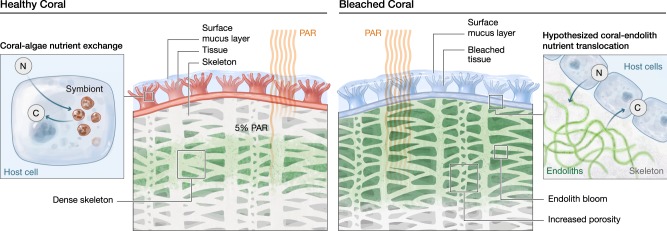Fig. 2.
Climate change affects endolithic microbiomes and their interactions with the coral host. a In the intact symbiosis, the nutrient exchange between coral cells and the endosymbiotic microalgae is maintained. In this scenario, endoliths remain deep in the skeleton. b Exposure to prolonged high-temperature anomalies causes the loss of Symbiodiniaceae from coral tissues, resulting in bleaching. Subsequently more light penetrates into the skeleton, causing endolithic microbiomes to bloom. Endoliths were previously shown to increase their biomass and primary production, physically reaching the animal tissues, and enhance the rates of organic carbon (photoassimilate) translocation to the animal host. It is hypothesized that nutrient exchange between the coral host and endoliths may potentially help the coral animal to survive or even to recover from bleaching. At the same time, the increased growth of endoliths may cause microbioerosion to intensify, undermining the structural integrity of the coral skeleton, and rendering the coral colony more vulnerable to breakage (e.g., during storm events)

